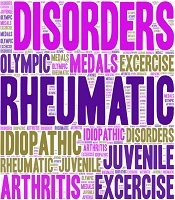The participation and success of individuals with rheumatic diseases in paralympic competitions are anticipated, but the possibility of engaging in professional sports while managing a rheumatic condition, such as rheumatoid arthritis (RA), remains a topic of debate.
Arian Salimi, an Iranian taekwondo athlete and gold medalist at the 2024 Paris Olympics, was diagnosed with juvenile idiopathic arthritis at the age of three. He experienced recurrent episodes of fever accompanied by arthritis in both knees and also suffered from ophthalmic problems such as anterior chamber involvement and uveitis. X-ray images showed bilateral knee joint inflammation with periarticular osteopenia, and his laboratory tests revealed a positive result for fluorescent antinuclear antibody (FANA). After receiving medical treatment, his symptoms were effectively controlled. He began exercising, and today, he is an Olympic gold medalist.
There is substantial evidence supporting the numerous health benefits of physical activity and exercise for individuals with RA, including improvements in joint health, physical function, mobility, and psychological well-being. Additionally, these activities help alleviate rheumatoid cachexia and fatigue without worsening symptoms or causing further joint damage (1-3).
Despite the well-documented benefits of physical activity, studies show that patients with RA are significantly less active than healthy individuals. Systematic reviews indicate that 71% of RA patients do not engage in regular physical activity, falling short of recommended levels (4-6). A recent randomized controlled trial revealed that although a cognitive-behavioral education program increased patients' intent to be physically active, it did not result in a change in their actual activity levels. These findings suggest that RA patients may face unique or more significant barriers to physical activity compared to the general population (7, 8).
Both quantitative and qualitative research clearly identify pain and fatigue as the primary arthritis-related barriers to regular physical activity. Other disease-related challenges include reduced mobility, functional limitations, and stiffness, all of which impede engagement in physical exercise (9-13). In addition to these physical challenges, qualitative studies also highlight issues such as the lack of specialized exercise programs for individuals with arthritis and a general lack of understanding regarding suitable exercise routines, which negatively impact physical activity levels (12).
The concerns regarding appropriate exercise for RA patients are often linked to fears of worsening the condition or causing joint damage. Moreover, patients frequently report that healthcare providers do not offer sufficient guidance on which exercises are appropriate for managing RA (14).
Current RA management typically involves disease-modifying drugs and biological agents, which can significantly reduce disease activity and structural damage. However, challenges remain, as some patients continue to struggle with achieving clinical remission or maintaining low disease activity levels. Non-pharmacological treatments, especially exercise therapy, have proven to be effective in alleviating symptoms and improving daily functioning in RA patients, and they have also been shown to reduce disease activity and severity (15-18).
Although many believe that RA poses a barrier to achieving athletic success, several individuals have shown that this is, in fact, a misconception. Arian Salimi is one example of this. Dina Rios, who was diagnosed with RA in 2008, faced severe distress upon her diagnosis. As a competitive runner, her training was significantly impacted during her first year of college due to persistent foot pain, which remained despite extensive rest. After consulting numerous doctors and undergoing multiple evaluations, she was ultimately diagnosed with RA. Despite setbacks, including two hip replacements and wrist surgery, Dina continued to pursue her passion for running. Initially, she could only manage a slow pace for 800 meters, which was both painful and discouraging. However, her persistence paid off, and she eventually competed in 5Ks, 10Ks, and two half marathons before transitioning to triathlons, which were less strenuous on her body. In 2015, she reached a major milestone by qualifying for and participating in her first USA Triathlon National Championship.
Jeri Strachner is another athlete with RA who has continued to compete in sports at a high level. Many athletes around the world are managing rheumatic disorders while still excelling in their respective fields, proving that these conditions do not necessarily prevent professional athletic participation.
In conclusion, rheumatic diseases should not be viewed as a barrier to exercise or athletic achievement. The experiences of individuals like Arian Salimi, Dina Rios, and others demonstrate that rheumatic conditions do not hinder professional athletic success. The main difference between Arian Salimi and the other two athletes is that Arian Salimi achieved success after the disease completely subsided, while the others were successful while struggling with the disease and its complications, including joint replacement. Therefore, it is crucial to challenge the belief that RA or other rheumatic diseases prevent individuals from reaching their full athletic potential.
